Ivan Brugere
Calibrating LLM Confidence by Probing Perturbed Representation Stability
May 27, 2025Abstract:Miscalibration in Large Language Models (LLMs) undermines their reliability, highlighting the need for accurate confidence estimation. We introduce CCPS (Calibrating LLM Confidence by Probing Perturbed Representation Stability), a novel method analyzing internal representational stability in LLMs. CCPS applies targeted adversarial perturbations to final hidden states, extracts features reflecting the model's response to these perturbations, and uses a lightweight classifier to predict answer correctness. CCPS was evaluated on LLMs from 8B to 32B parameters (covering Llama, Qwen, and Mistral architectures) using MMLU and MMLU-Pro benchmarks in both multiple-choice and open-ended formats. Our results show that CCPS significantly outperforms current approaches. Across four LLMs and three MMLU variants, CCPS reduces Expected Calibration Error by approximately 55% and Brier score by 21%, while increasing accuracy by 5 percentage points, Area Under the Precision-Recall Curve by 4 percentage points, and Area Under the Receiver Operating Characteristic Curve by 6 percentage points, all relative to the strongest prior method. CCPS delivers an efficient, broadly applicable, and more accurate solution for estimating LLM confidence, thereby improving their trustworthiness.
MAFE: Multi-Agent Fair Environments for Decision-Making Systems
Feb 25, 2025Abstract:Fairness constraints applied to machine learning (ML) models in static contexts have been shown to potentially produce adverse outcomes among demographic groups over time. To address this issue, emerging research focuses on creating fair solutions that persist over time. While many approaches treat this as a single-agent decision-making problem, real-world systems often consist of multiple interacting entities that influence outcomes. Explicitly modeling these entities as agents enables more flexible analysis of their interventions and the effects they have on a system's underlying dynamics. A significant challenge in conducting research on multi-agent systems is the lack of realistic environments that leverage the limited real-world data available for analysis. To address this gap, we introduce the concept of a Multi-Agent Fair Environment (MAFE) and present and analyze three MAFEs that model distinct social systems. Experimental results demonstrate the utility of our MAFEs as testbeds for developing multi-agent fair algorithms.
Interpretable LLM-based Table Question Answering
Dec 16, 2024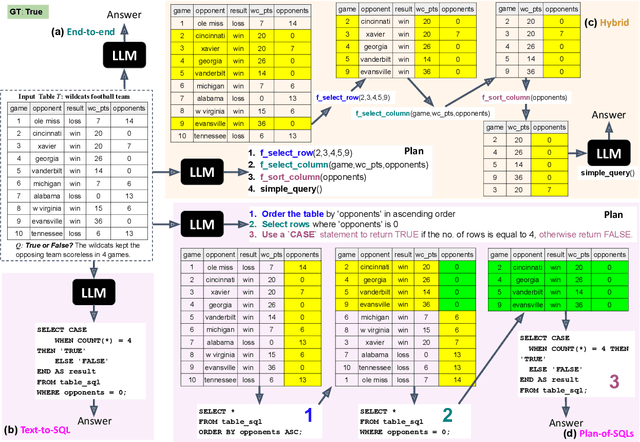

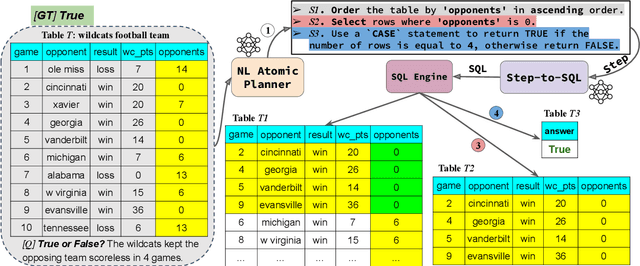

Abstract:Interpretability for Table Question Answering (Table QA) is critical, particularly in high-stakes industries like finance or healthcare. Although recent approaches using Large Language Models (LLMs) have significantly improved Table QA performance, their explanations for how the answers are generated are ambiguous. To fill this gap, we introduce Plan-of-SQLs ( or POS), an interpretable, effective, and efficient approach to Table QA that answers an input query solely with SQL executions. Through qualitative and quantitative evaluations with human and LLM judges, we show that POS is most preferred among explanation methods, helps human users understand model decision boundaries, and facilitates model success and error identification. Furthermore, when evaluated in standard benchmarks (TabFact, WikiTQ, and FetaQA), POS achieves competitive or superior accuracy compared to existing methods, while maintaining greater efficiency by requiring significantly fewer LLM calls and database queries.
Cross-Domain Graph Data Scaling: A Showcase with Diffusion Models
Jun 04, 2024Abstract:Models for natural language and images benefit from data scaling behavior: the more data fed into the model, the better they perform. This 'better with more' phenomenon enables the effectiveness of large-scale pre-training on vast amounts of data. However, current graph pre-training methods struggle to scale up data due to heterogeneity across graphs. To achieve effective data scaling, we aim to develop a general model that is able to capture diverse data patterns of graphs and can be utilized to adaptively help the downstream tasks. To this end, we propose UniAug, a universal graph structure augmentor built on a diffusion model. We first pre-train a discrete diffusion model on thousands of graphs across domains to learn the graph structural patterns. In the downstream phase, we provide adaptive enhancement by conducting graph structure augmentation with the help of the pre-trained diffusion model via guided generation. By leveraging the pre-trained diffusion model for structure augmentation, we consistently achieve performance improvements across various downstream tasks in a plug-and-play manner. To the best of our knowledge, this study represents the first demonstration of a data-scaling graph structure augmentor on graphs across domains.
BuDDIE: A Business Document Dataset for Multi-task Information Extraction
Apr 05, 2024Abstract:The field of visually rich document understanding (VRDU) aims to solve a multitude of well-researched NLP tasks in a multi-modal domain. Several datasets exist for research on specific tasks of VRDU such as document classification (DC), key entity extraction (KEE), entity linking, visual question answering (VQA), inter alia. These datasets cover documents like invoices and receipts with sparse annotations such that they support one or two co-related tasks (e.g., entity extraction and entity linking). Unfortunately, only focusing on a single specific of documents or task is not representative of how documents often need to be processed in the wild - where variety in style and requirements is expected. In this paper, we introduce BuDDIE (Business Document Dataset for Information Extraction), the first multi-task dataset of 1,665 real-world business documents that contains rich and dense annotations for DC, KEE, and VQA. Our dataset consists of publicly available business entity documents from US state government websites. The documents are structured and vary in their style and layout across states and types (e.g., forms, certificates, reports, etc.). We provide data variety and quality metrics for BuDDIE as well as a series of baselines for each task. Our baselines cover traditional textual, multi-modal, and large language model approaches to VRDU.
Balancing Fairness and Accuracy in Data-Restricted Binary Classification
Mar 12, 2024Abstract:Applications that deal with sensitive information may have restrictions placed on the data available to a machine learning (ML) classifier. For example, in some applications, a classifier may not have direct access to sensitive attributes, affecting its ability to produce accurate and fair decisions. This paper proposes a framework that models the trade-off between accuracy and fairness under four practical scenarios that dictate the type of data available for analysis. Prior works examine this trade-off by analyzing the outputs of a scoring function that has been trained to implicitly learn the underlying distribution of the feature vector, class label, and sensitive attribute of a dataset. In contrast, our framework directly analyzes the behavior of the optimal Bayesian classifier on this underlying distribution by constructing a discrete approximation it from the dataset itself. This approach enables us to formulate multiple convex optimization problems, which allow us to answer the question: How is the accuracy of a Bayesian classifier affected in different data restricting scenarios when constrained to be fair? Analysis is performed on a set of fairness definitions that include group and individual fairness. Experiments on three datasets demonstrate the utility of the proposed framework as a tool for quantifying the trade-offs among different fairness notions and their distributional dependencies.
Bounding the Excess Risk for Linear Models Trained on Marginal-Preserving, Differentially-Private, Synthetic Data
Feb 06, 2024Abstract:The growing use of machine learning (ML) has raised concerns that an ML model may reveal private information about an individual who has contributed to the training dataset. To prevent leakage of sensitive data, we consider using differentially-private (DP), synthetic training data instead of real training data to train an ML model. A key desirable property of synthetic data is its ability to preserve the low-order marginals of the original distribution. Our main contribution comprises novel upper and lower bounds on the excess empirical risk of linear models trained on such synthetic data, for continuous and Lipschitz loss functions. We perform extensive experimentation alongside our theoretical results.
A Canonical Data Transformation for Achieving Inter- and Within-group Fairness
Oct 23, 2023



Abstract:Increases in the deployment of machine learning algorithms for applications that deal with sensitive data have brought attention to the issue of fairness in machine learning. Many works have been devoted to applications that require different demographic groups to be treated fairly. However, algorithms that aim to satisfy inter-group fairness (also called group fairness) may inadvertently treat individuals within the same demographic group unfairly. To address this issue, we introduce a formal definition of within-group fairness that maintains fairness among individuals from within the same group. We propose a pre-processing framework to meet both inter- and within-group fairness criteria with little compromise in accuracy. The framework maps the feature vectors of members from different groups to an inter-group-fair canonical domain before feeding them into a scoring function. The mapping is constructed to preserve the relative relationship between the scores obtained from the unprocessed feature vectors of individuals from the same demographic group, guaranteeing within-group fairness. We apply this framework to the COMPAS risk assessment and Law School datasets and compare its performance in achieving inter-group and within-group fairness to two regularization-based methods.
Hyper-parameter Tuning for Fair Classification without Sensitive Attribute Access
Feb 02, 2023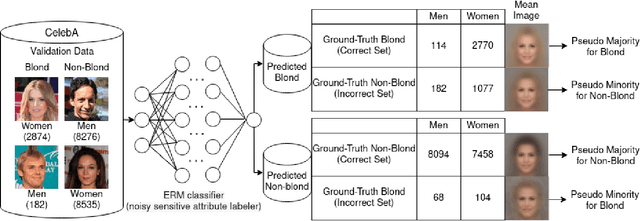

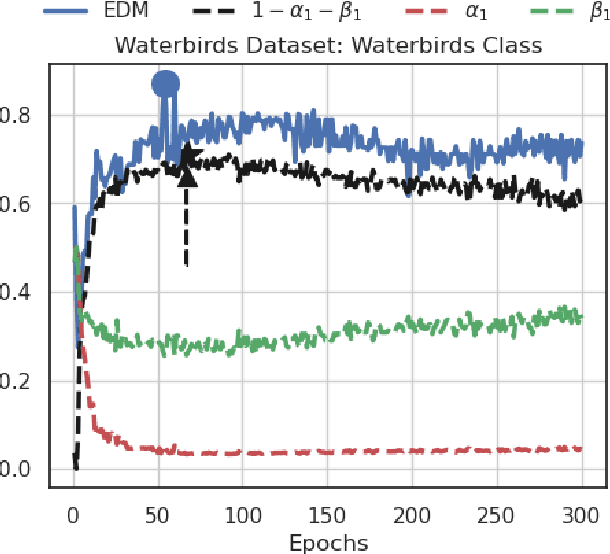

Abstract:Fair machine learning methods seek to train models that balance model performance across demographic subgroups defined over sensitive attributes like race and gender. Although sensitive attributes are typically assumed to be known during training, they may not be available in practice due to privacy and other logistical concerns. Recent work has sought to train fair models without sensitive attributes on training data. However, these methods need extensive hyper-parameter tuning to achieve good results, and hence assume that sensitive attributes are known on validation data. However, this assumption too might not be practical. Here, we propose Antigone, a framework to train fair classifiers without access to sensitive attributes on either training or validation data. Instead, we generate pseudo sensitive attributes on the validation data by training a biased classifier and using the classifier's incorrectly (correctly) labeled examples as proxies for minority (majority) groups. Since fairness metrics like demographic parity, equal opportunity and subgroup accuracy can be estimated to within a proportionality constant even with noisy sensitive attribute information, we show theoretically and empirically that these proxy labels can be used to maximize fairness under average accuracy constraints. Key to our results is a principled approach to select the hyper-parameters of the biased classifier in a completely unsupervised fashion (meaning without access to ground truth sensitive attributes) that minimizes the gap between fairness estimated using noisy versus ground-truth sensitive labels.
Comparing Apples to Oranges: Learning Similarity Functions for Data Produced by Different Distributions
Aug 26, 2022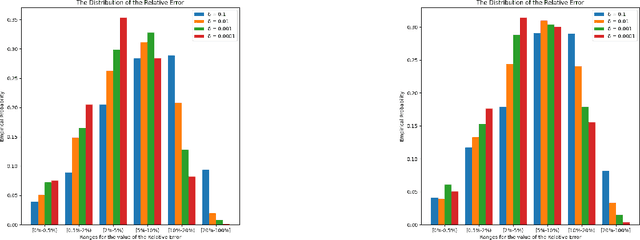
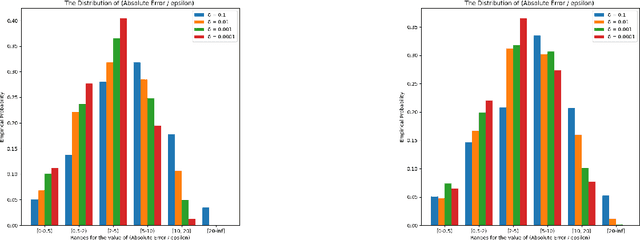
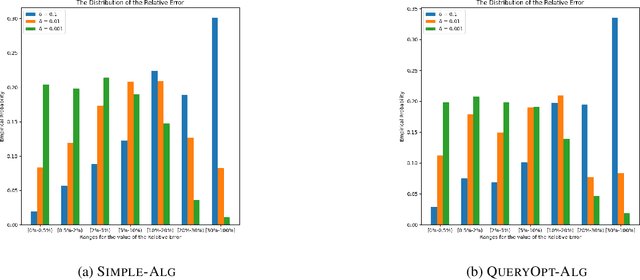
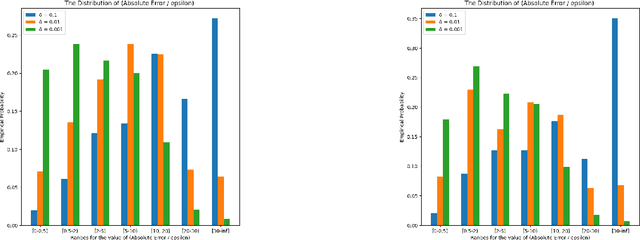
Abstract:Similarity functions measure how comparable pairs of elements are, and play a key role in a wide variety of applications, e.g., Clustering problems and considerations of Individual Fairness. However, access to an accurate similarity function should not always be considered guaranteed. Specifically, when the elements to be compared are produced by different distributions, or in other words belong to different ``demographic'' groups, knowledge of their true similarity might be very difficult to obtain. In this work, we present a sampling framework that learns these across-groups similarity functions, using only a limited amount of experts' feedback. We show analytical results with rigorous bounds, and empirically validate our algorithms via a large suite of experiments.
 Add to Chrome
Add to Chrome Add to Firefox
Add to Firefox Add to Edge
Add to Edge